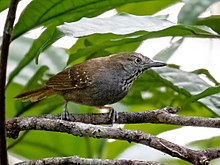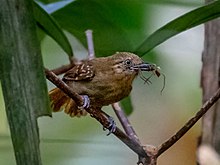| Brown-bellied stipplethroat | |
|---|---|

| |
| A male at Manaus, Amazonas state, Brazil. | |

| |
| A female at Manaus, Amazonas state, Brazil. | |
| Conservation status | |
 Least Concern (IUCN 3.1) | |
| Scientific classification | |
| Domain: | Eukaryota |
| Kingdom: | Animalia |
| Phylum: | Chordata |
| Class: | Aves |
| Order: | Passeriformes |
| Family: | Thamnophilidae |
| Genus: | Epinecrophylla |
| Species: | E. gutturalis |
| Binomial name | |
| Epinecrophylla gutturalis (Sclater, PL & Salvin, 1881) | |

| |
| Synonyms | |
|
Myrmotherula gutturalis | |
The brown-bellied stipplethroat, previously called brown-bellied antwren (Epinecrophylla gutturalis) is a species of bird in subfamily Thamnophilinae of family Thamnophilidae, the "typical antbirds". It is found in Brazil, French Guiana, Guyana, Suriname, and Venezuela.
Taxonomy and systematics
The brown-bellied stipplethroat was described by the English ornithologists Philip Sclater and Osbert Salvin in 1881 and given the binomial name Myrmotherula gutturalis. Based on genetic and vocal studies it and seven other members of the genus were moved to the genus Epinecrophylla that was created in 2006. All were eventually named "stipplethroats" to highlight a common feature and to set them apart from Myrmotherula antwrens.
The brown-bellied stipplethroat is monotypic.
Description
The brown-bellied stipplethroat is 9.5 to 10.5 cm (3.7 to 4.1 in) long and weighs 7.5 to 9.5 g (0.26 to 0.34 oz). Adult males have a mostly gray face and a black throat with white spots. They have an olive-brown crown, upperparts, tail, and flight feathers. Their wing coverts are a darker olive-brown with small white tips. Their breast and upper belly are gray that becomes gray with a clay-colored tinge towards the vent area. Adult females have a mostly pale brownish buff face and throat. Their crown and upperparts are yellowish olive-brown and their tail reddish. Their wing coverts have pink or pinkish buff tips. Their underparts are pale brownish buff that is darker on the flanks and crissum. Juveniles have large spots on the wing coverts that almost form a continuous band.
Distribution and habitat
The brown-bellied stipplethroat is found from eastern Venezuela east through the Guianas and south in Brazil to the Amazon River from the Rio Branco and lower Rio Negro to the Atlantic. It inhabits the understorey of terra firme evergreen forest from sea level to 1,000 m (3,300 ft) though it mostly occurs below 600 m (2,000 ft).
Behavior
Movement
The brown-bellied stipplethroat is believed to be a year-round resident throughout its range.
Feeding
The brown-bellied stipplethroat's diet is not known in detail but includes insects and spiders. It typically forages singly or in pairs, and usually as part of a mixed-species feeding flock. It mostly forages in the forest understory; some studies found that it seldom exceeds 9 m (30 ft) above the ground but others have noted it feeding as high as 15 m (50 ft). It forages mostly in vine tangles, on hanging clusters of dead leaves and in dead leaves and other debris trapped in the vines.
Territorial defense
Male brown-bellied stipplethroats display to each other from perches less than 1 m (3 ft) apart; they puff up their back plumage, flare their throat feathers, sway back and forth, and continuously vocalize.
Breeding
The brown-bellied stipplethroat's breeding season is not well known but appears to vary geographically. It nests in February and March in French Guiana and (possibly not continuously) from May to December in Brazil. Nests in French Guiana were a deep pouch of plant and fungal fibers and dead leaves suspended from the fork of a thin branch about 1.5 m (5 ft) above the ground. One in Brazil was a domed ball of twigs and leaves low to the ground in a bush. The clutch size is two eggs. The incubation period is not known; fledging occurs about 11 days after hatch. Both parents incubate the clutch and brood and provision nestlings.
|
Songs and calls Listen to brown-bellied stipplethroat on xeno-canto |
Vocalization
The brown-bellied stipplethroat's song is an "extr. high, thin, shivering, descending 't-srrrrrruw' ". Its calls include a "distinctive 'chip' followed by a series of c. 5 notes that rise and fall in pitch and intensity", a "single downslurred note", and a "rubbery rattle rising and falling in pitch and intensity".
Status
The IUCN originally in 2004 assessed the brown-bellied stipplethroat as being of Least Concern, then in 2012 as Threatened, and since 2022 again as of Least Concern. It has a very large range and an estimated population of more than one million mature individuals; the latter is believed to be decreasing. "Possible threats to the species include logging and mining activities, both of which appear to be increasing...their impact on overall habitat availability is currently believed to be low. Deforestation due to conversion for subsistence and industrial agriculture may however be locally higher". It is considered fairly common throughout its range. It occurs in several protected areas and in "large contiguous expanses of intact habitat which, although not formally protected, are at little current risk of development".
References
- ^ BirdLife International (2023). "Epinecrophylla gutturalis". IUCN Red List of Threatened Species. 2023: e.T22701466A223385432. doi:10.2305/IUCN.UK.2023-1.RLTS.T22701466A223385432.en. Retrieved 11 January 2024.
- ^ Remsen, J. V., Jr., J. I. Areta, E. Bonaccorso, S. Claramunt, G. Del-Rio, A. Jaramillo, D. F. Lane, M. B. Robbins, F. G. Stiles, and K. J. Zimmer. Version 26 November 2023. A classification of the bird species of South America. American Ornithological Society. https://www.museum.lsu.edu/~Remsen/SACCBaseline.htm retrieved November 27, 2023
- ^ Gill, Frank; Donsker, David; Rasmussen, Pamela, eds. (January 2024). "Antbirds". IOC World Bird List. v 14.1. Retrieved January 4, 2024.
- Remsen, J. V., Jr., J. I. Areta, E. Bonaccorso, S. Claramunt, G. Del-Rio, A. Jaramillo, D. F. Lane, M. B. Robbins, F. G. Stiles, and K. J. Zimmer. Version 26 November 2023. Species Lists of Birds for South American Countries and Territories. https://www.museum.lsu.edu/~Remsen/SACCCountryLists.htm retrieved November 27, 2023
- Sclater, Philip L.; Salvin, Osbert (1881). "Descriptions of some new species of South-American birds of the families Tyrannidae and Formicariidae". Ibis. 4th Series. 5 (2): 267–271 . doi:10.1111/j.1474-919X.1881.tb06025.x.
- Isler, M.L.; Lacerda, D.R.; Isler, P.R.; Hackett, S.J.; Rosenberg, K.V.; Brumfield, R.T. (2006). "Epinecrophylla, a new genus of antwrens (Aves: Passeriformes: Thamnophilidae)" (PDF). Proceedings of the Biological Society of Washington. 119 (4): 522–527. doi:10.2988/0006-324X(2006)119[522:EANGOA]2.0.CO;2. Archived from the original (PDF) on 2010-06-29. Retrieved 2018-03-04.
- ^ Zimmer, K. and M.L. Isler (2020). Brown-bellied Stipplethroat (Epinecrophylla gutturalis), version 1.0. In Birds of the World (J. del Hoyo, A. Elliott, J. Sargatal, D. A. Christie, and E. de Juana, Editors). Cornell Lab of Ornithology, Ithaca, NY, USA. https://doi.org/10.2173/bow.brbant2.01 retrieved January 11, 2024
- ^ van Perlo, Ber (2009). A Field Guide to the Birds of Brazil. New York: Oxford University Press. pp. 240–241. ISBN 978-0-19-530155-7.
| Taxon identifiers | |
|---|---|
| Epinecrophylla gutturalis | |
| Myrmotherula gutturalis | |
